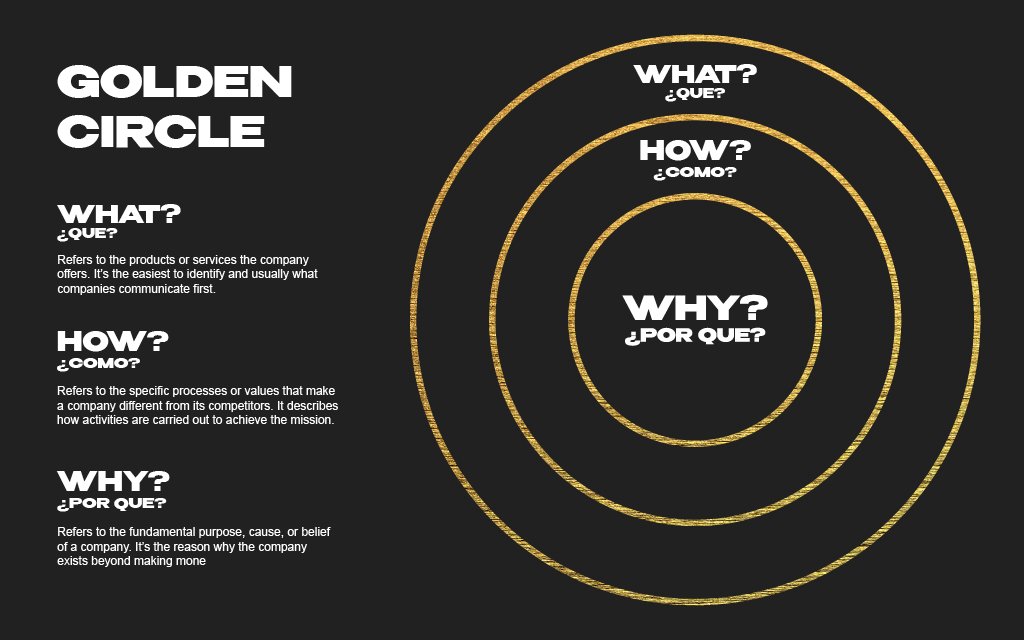The Golden Circle is a concept presented as a circle, like its name suggests, with layers similar to onions and ogres. The three layers represent the questions: why, how, and what. The theory suggests that by answering these three questions, a company can understand the purpose of its business.
The Golden Circle is mentioned in the book Start with Why by Simon Sinek. In the book, Sinek discusses how crucial it is for brands to know why they were created and how this understanding helps them grow.
The 3 Layers of the Golden Circle
Each layer represents the questions: why, how, and what. Although they seem simple, they are a great exercise to understand a company’s purpose. In Start with Why, Sinek advises companies or their leaders to use the Golden Circle starting by addressing the why.

Golden Circle: Why?
In the first layer of the Golden Circle, Simon Sinek suggests that this is where you need to write down the purpose of your business. We must identify the reason for the existence of this business or venture, what drives and motivates all actions. This is the company’s purpose.
If the company truly identifies its why, everything moves naturally and flows. For this reason, it is the starting point for businesses—if you know why you are doing it, it gives you a direction for your entire business or venture.
Golden Circle: How?
In the middle layer of the Golden Circle, we determine and establish the strategies we will apply to achieve results aligned with the company’s purpose. This is where the company’s action or work plan is located and should always align with the company’s values.
Golden Circle: What?
In the last layer of the Golden Circle, Simon Sinek points out that this is where we must specify what the company sells or does. This layer of the Golden Circle is the easiest to understand because it involves the product or service the company sells.
Why Have the Golden Circle?
Having the Golden Circle is essential for an organization, especially if it is not clear about the reason for its existence. Having this information and understanding it allows you to conduct various marketing and communication campaigns, thus achieving better results.
By leveraging the Golden Circle, we can achieve various objectives and facilitate decision-making and good outcomes. Some of the impacts on your business include:
Inspiring Communication
Starting with the why can make all your communication exciting, impactful, and inspiring, increasing loyalty through a sense of belonging.
Example: Apple doesn’t just sell computers; it promotes challenging the status quo and innovation, resonating with a certain profile of customers.
Brand Strategy
Having a why helps the brand to be strong and coherent, achieving omnichannel presence as previously shared, which allows you to have a brand narrative that communicates clearly and maintains good communication.
Example: Patagonia, the clothing brand, achieves good communication focused on its purpose of sustainability and environmental protection, reflected in all its corporate actions, marketing, and products.
Differentiate from the Market
When you compete only by product (the “What”), you will likely compete on price. However, if you have a “Why” and “How,” you begin to compete on different variables.
Example: Southwest Airlines is distinguished not only by its low-cost flights (the “What”) but also by its commitment to friendly service and the democratization of air travel (the “How” and “Why”).
Customer Loyalty
Customers are more likely to become loyal and advocates for the brand if they can identify with the purpose, the Why of the company. This simplifies customer satisfaction.
Example: Tesla customers feel part of a larger mission towards sustainability and innovation in mobility.
Do you already know your Why, do you know why your company does what it does? If not, we recommend you start today and begin applying it.
Welcome to the new norm.


